World Food Day 2023 - Deriving More Food, Feed, and Income Out of Every Drop of Green Water

In a world facing the challenge of feeding a growing population in a climate crisis, it is critical to produce more food and feed with less water. For farmers in dry, arid places like the Central and West Asia and North Africa (CWANA) region, scarce and unpredictable rainfall poses even more acute challenges to cultivating crops.
ICARDA, committed to sustainability and innovation, envisages a more food-secure and water-conscious world. Our evidence-based science provides a glimpse into the future of sustainable small-scale farming in regions such as the Middle East, North Africa, and South Asia, where every precious drop of green water—the water available to plants in the soil—is utilized to its fullest potential.
Supplemental irrigation: a game-changer during drought
During extended drought, ICARDA’s research demonstrates that supplemental irrigation can be decisive in continued food production. The precise application of 28–166 millimeters of extra water can make a significant difference in extreme drought years, increasing wheat production by 2–3 tons/ha. A more successful crop means more straw for animals, too, which improves income for farmers and nutrition for everyone.
Supplemental irrigation - the addition of limited amounts of water to essentially rainfed crops to improve and stabilize yields when rainfall fails to provide sufficient moisture for normal plant growth.
- Wheat yields increased from 1.25 to 3 t ha-1 in Syria, from 4.6 to 5.8 t ha-1 in Morocco, and from 2.2 to 3.4 t ha-1 in Iran
- In the highlands of Turkey, applying 50 mm of Sl to wheat sown early increased grain yield by more than 60%, adding more than 2 t ha to the average rainfed yield of 3.2t ha. Water productivity (WP) reached 4 4 kg/m3
- In Kurdistan region, there was a 91-200% average increase in crop yield when switched from rainfed to mm supplemental irrigation, and water productivity increased from 0.35 to as much as 0. 73 kg/m3
READ MORE:
Supplemental Irrigation: A promising Climate-Smart Practice for Dryland Agriculture
Diversifying crops for efficient use of green water
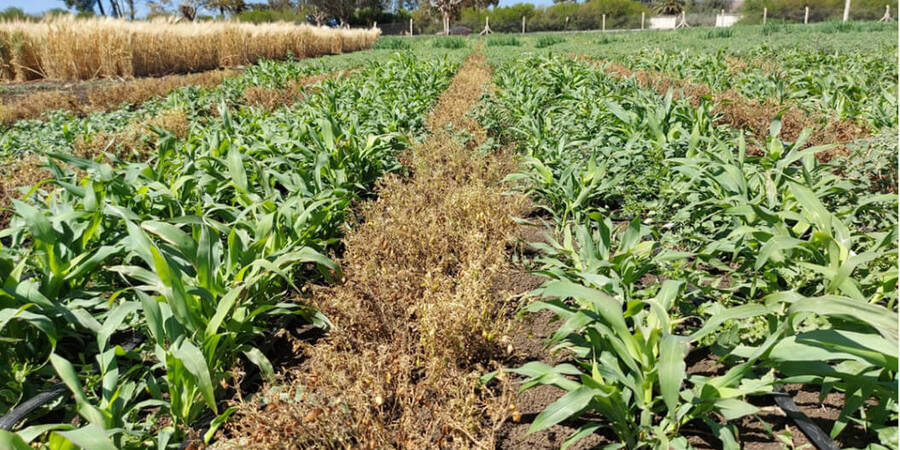
More than 80% of the food-cropped area worldwide is under cereal. But many cereal crops—including wheat—are heavy consumers of water. Incorporating crops with lower water requirements in dryland environments can secure harvests and strengthen livelihoods. ICARDA explores ways to improve the resilience of food systems by diversifying the choices of appropriate crops and varieties.
In a diversified spring crop tested in Morocco, onion produced a high yield and income ($11,378/ha) along with quinoa ($10,523/ha), chickpea ($1,111/ha) and bean ($982/ha). Water use efficiency (WUE) was significantly higher with the inclusion of spring crop than a sole lentil and wheat crop.
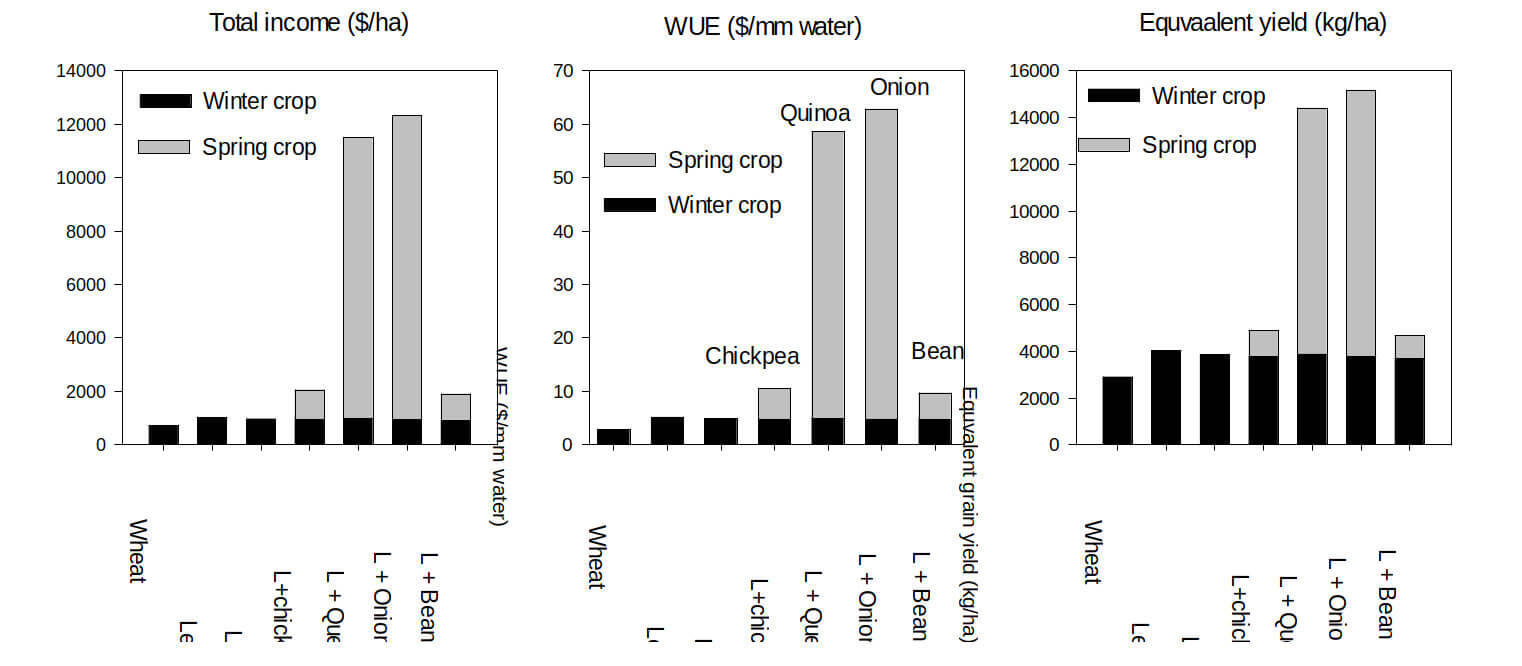
READ MORE: Female Agronomists in the Drylands - Diversify, Enrich, and Restore
WATCH VIDEO: Diversified cropping systems for sustainable intensification of dryland family farming
Conservation agriculture’s novel approaches
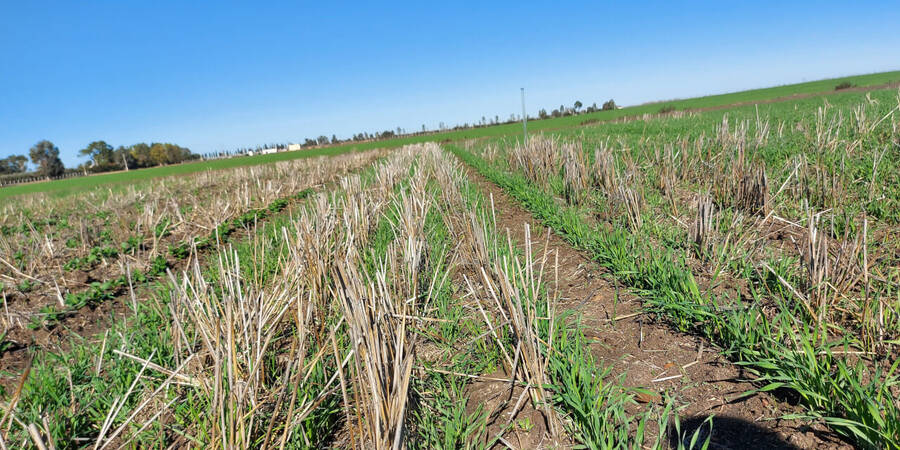
Conservation agriculture practices, such as reduced tillage, residue retention, and crop rotation, are effective farming methods for drylands. They improve soil health and conserve soil moisture, which leads to increased crop productivity and biomass production and enhanced resilience to adverse weather conditions.
The Benefits of Conservation Agriculture
When the three principles of CA are used along with good agronomic practices, many significant benefits are produced at different levels. The benefits of CA can be broadly characterized into four broad categories: socio-economic (livelihoods and wellbeing), enhanced agricultural productivity (yield, biomass, and quality), resource conservation, and improved environmental sustainability. CA is an important way of coping with climate change and increasingly variable and unpredictable rainfall, especially in Mediterranean rainfed environments, as reported by Devkota et al. (2022). Many of these benefits accrue at the farm level, while others accrue at watershed and community levels -and some at a global level.
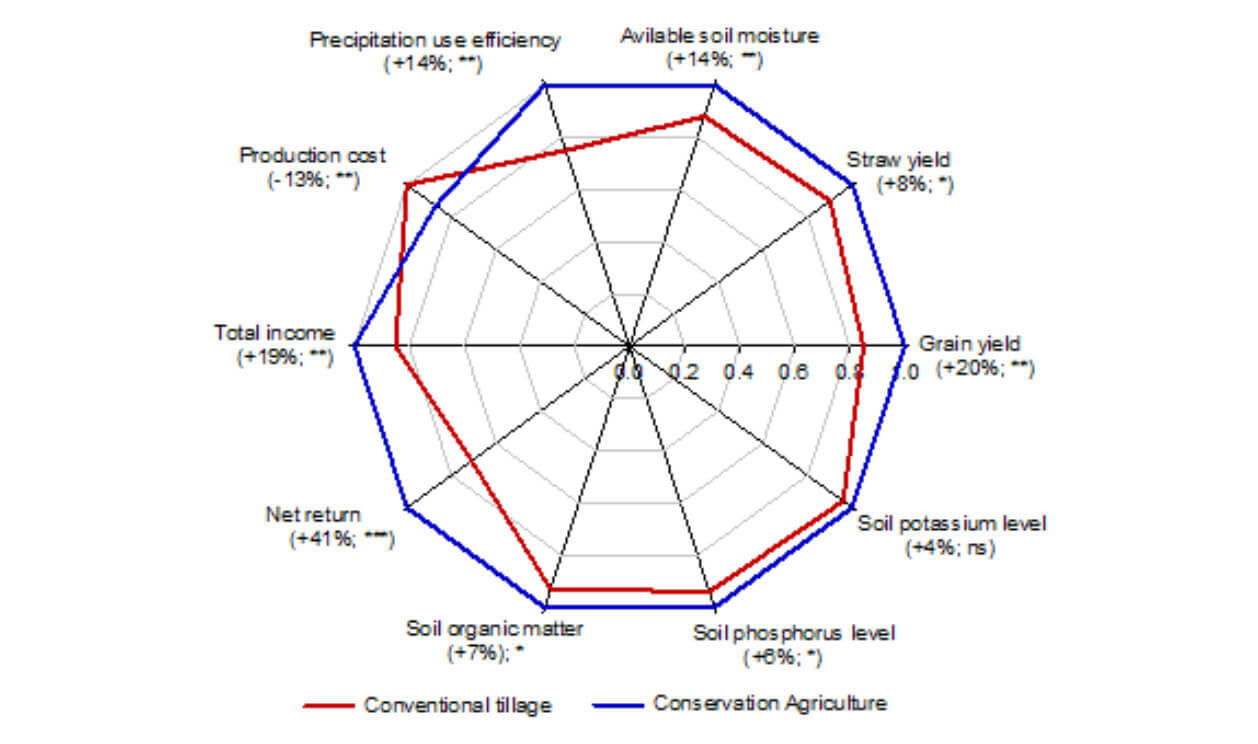
READ MORE:
Growing climate resilience from the soil up Features- Nature Middle East (natureasia.com)
Devkota, M., K. P. Devkota, Shiv Kumara. 2022. Conservation agricuiture improves agronomic, economic, and soil fertility indicators for a clay soil in a rainfed Mediterranean climate in Morocco. Agricultural Systems.
Dual purpose crops for food and forage
Barley is a major cereal crop for mixed crop–livestock systems in drylands, important for both food and forage. The choice of better varieties, seeding time, and agronomic management can increase its grain and forage production. For example, dual purpose barley produced 7% more total biomass when cut twice in early vegetative growth compared with no cutting.
Micro-scale water harvesting with native shrubs
Micro water harvesting using is an approach to enhance the health of especially arid and degraded lands. It utilizes machinery to excavate small pits in the soil that collect rainwater during precipitation events. These pits serve as reservoirs, storing water to nurture the growth of young plants, predominantly using a specialized tractor plow and the planting of small shrubs within these pits. Over time, these pits naturally fill, allowing the plants to assume the role of capturing rainwater and regulating the speed of runoff. This process fosters a more robust ecosystem with an increased presence of shrubs, which can serve as a valuable source of sustenance for livestock.
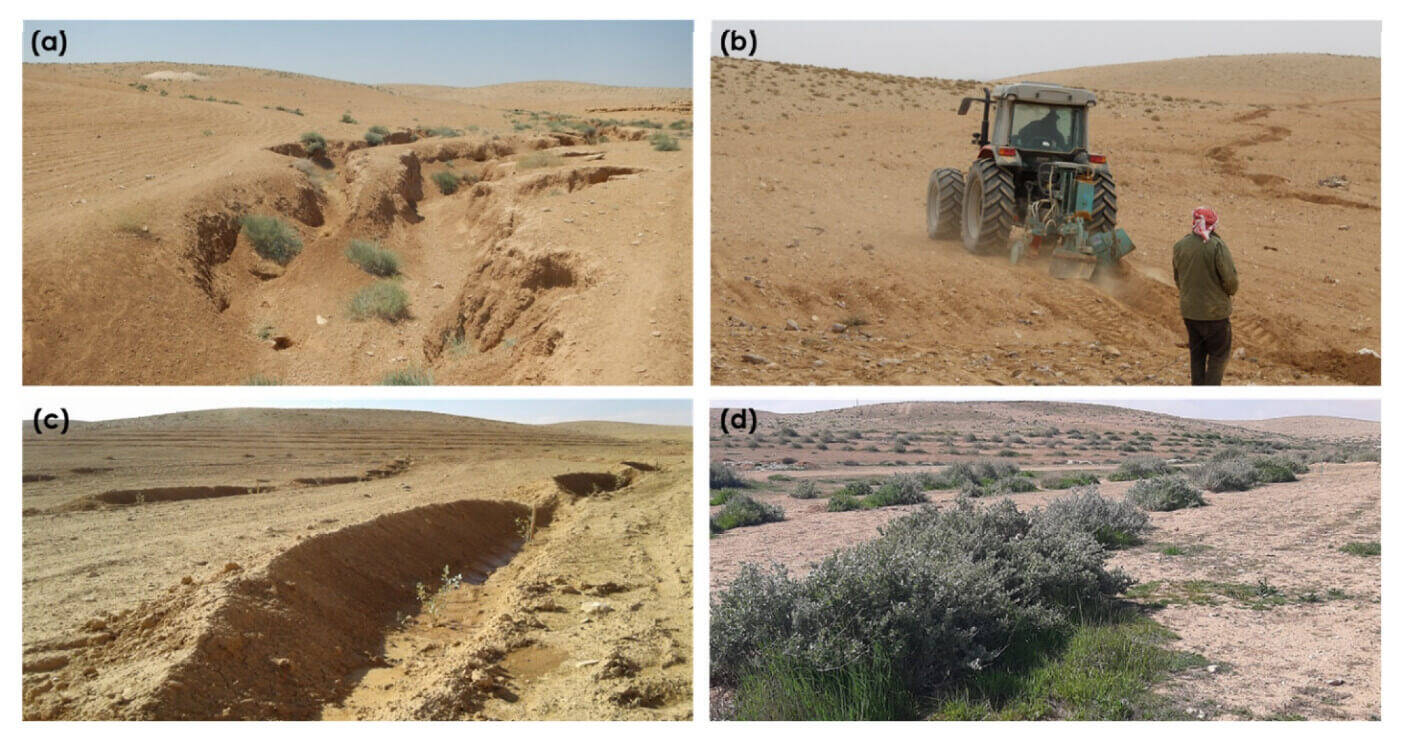
Rangeland restoration through water harvesting in Jordan
In areas of Jordan where annual rainfall is less than 200mm, ICARDA established a watershed in 2016 under sustainable land management practices. This included micro water harvesting with native shrubs and mes0 (Marab see below) water harvesting areas incorporating barley. The two practices aim to combat land degradation and promote sustainable land use. Restoring degraded rangelands in Jordan is crucial for enhancing and preserving fragile ecosystems' productivity and resilience. To achieve long-term sustainability, it is vital to maintain a balanced interaction between rangeland hydrology and vegetation. The Rangeland Hydrological and Erosion Model was used to understand restoration's impact on surface runoff, erosion, and ecosystem functions. Our findings revealed that restoring the degraded areas decreased annual surface runoff, which dropped from an average of 23.5 mm/year to 19.1 mm/year. Similarly, soil erosion rates reduced significantly from 3.3 to 1.3 tons/ha/year. Over time, the restoration approach moved rangeland water and sediment dynamics closer to baseline conditions, which were 16.9 mm/year runoff rates and 0.85 tons/ha/year soil loss. This suggests that restoration is a promising method for revitalizing degraded ecosystems and approximating historical hydrological regimes.
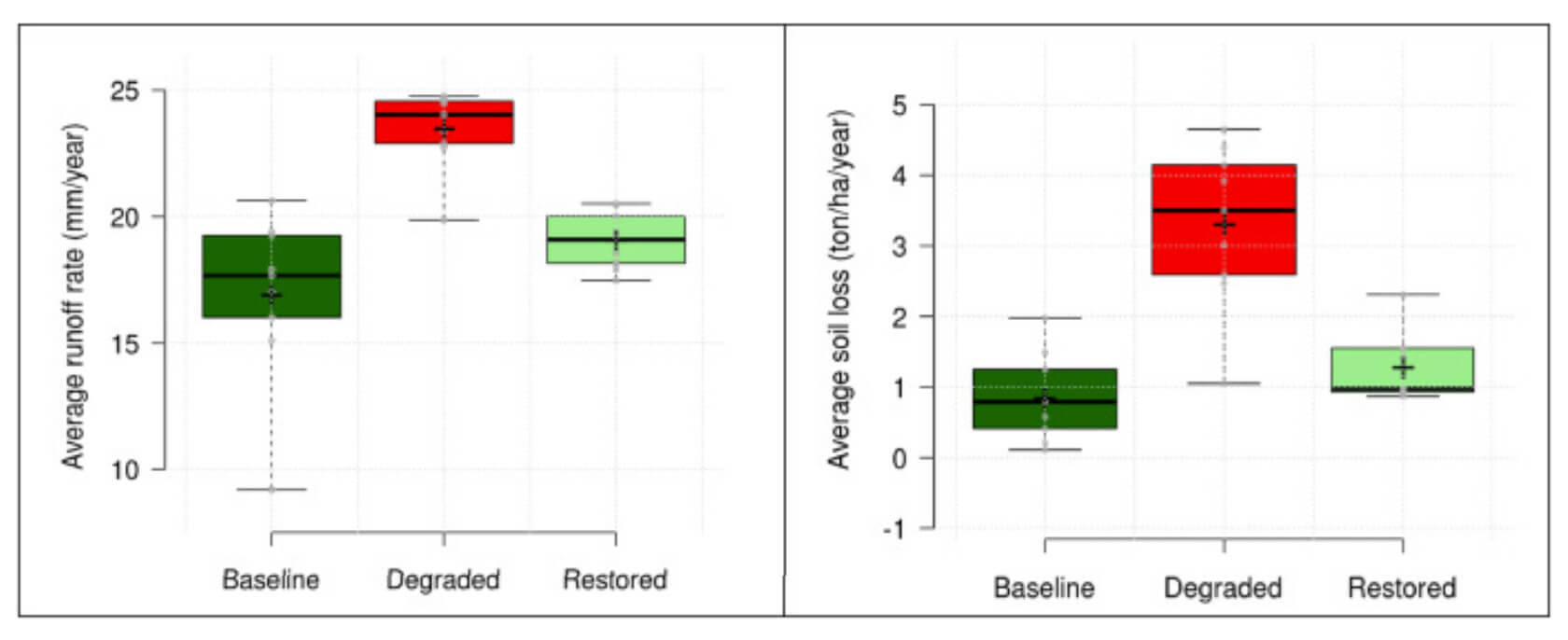
READ MORE:
Jordan's restoration efforts push back on degrading land
Meso-scale Marab water harvesting
The ‘Marab’ is a traditional Middle Eastern downstream water harvesting technology that can be implemented as part of an integrated watershed approach. It diverts and spreads excess runoff over deep-soil flood plains to support high-yield agriculture in arid environments. This technology using today’s machinery involves gully-filling, grading/leveling of the seed bed, and the construction of bunds and spillways to create compartments for flood-irrigated agriculture. Capturing most of the water from the watershed and utilizing flood/macro-catchment water harvesting enables the production of high-yield barley, which serves as fodder for livestock. The technology improves soil moisture, fertility, and vegetative cover, leading to increased agricultural productivity and improved livelihoods for local communities. It also helps mitigate downstream flooding, retain water for later use, and trap fertile sediments from upstream areas.

Modeling-based performance assessment of Marab water harvesting
The effectiveness of the Marab technology can vary considerably based on factors like the local climate, soil characteristics, and how the system is managed. Despite limited scientific evidence supporting its widespread use, the Marab system has proven its ability to withstand changes in rainfall patterns in an ICARDA assessment in Jordan, highlighting its durability.
-
With Marab-based farming, barley production averaged 8.37 tons/ha, compared to highly variable yields of 0.34 tons/ha without Marab.
-
The assessment of soil textures revealed that silty soils hold the highest potential, producing up to 9.25 tons/ha of barley, while clay soils yielded around 6.60 tons/ha.
-
Exploring various climate scenarios, a temperature increase of 0.5°C resulted in a significant production decline of 4–8%, while a 20% reduction in precipitation decreased biomass production by 4–10%.
-
The simulations emphasize the critical role of timing and frequency of flood events: eliminating the last and first flood events led to a decline in biomass production by approximately 50% and 80%, respectively, with the barley failing to develop if both events were absent.
Comparing the biomass production of Marab technology with conventional rainfed cropping in arid regions of Jordan
| Season | Marab (tons/ha) | Rainfed (tons/ha) |
| 2019/2020 | 9.78 | 1.00 |
| 2020/2021 | 7.31 | 0.01 |
| 2021/2022 | 8.01 | 0.02 |
READ MORE:
Modelling the Indigenous Water Harvesting Technique of the Marab in Jordan
Renzi, N., Villani, L., Haddad, M., Strohmeier, S., Widyan, J. A., Bresci, E., & Castelli, G. (2023). Modeling based performan ce assessment of an indigenous macro-catchment water harvesting technique (Marab) in the Jordanian Badia. Land Degradation & Development.
Celebrating smart solutions
ICARDA’s science-based approaches represent more than a mere shift in water utilization within agriculture— they offer a beacon of hope for regions grappling with water scarcity and climatic uncertainty. By optimizing the use of green water, diversifying crop choices, and implementing sustainable land management practices, we are looking toward a future defined by abundance in food, feed, and economic prosperity for all. Farmers have the power to cultivate more crops, resulting in increased household food production and greater financial resources for their essential needs. This, in turn, fortifies local communities, rendering them more resilient to adversity.
This World Food Day, let us celebrate the brilliance of forward-thinking ideas like these. They not only make each precious drop of water count but also hold the promise of a world where the challenges of water scarcity and variable weather are met with innovative solutions that ensure equitable access to sustenance and economic well-being.
-----------------------------------------------------------



